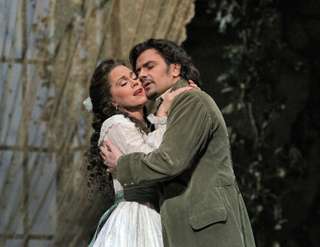|
Back
Dumas’ Camille Blossoms in this Lavish La Traviata San Diego
Civic Theater
04/17/2010 - & 20, 23, 25 April 2010
Giuseppe Verdi: La Traviata
Elizabeth Futral (Violetta Valéry), Marius Brenciu (Alfredo Germont), Alan Opie (Giorgio Germont), Joseph Hu (Gaston), Scott Sikon (Marquis d’Obigny), Suzanna Guzmán (Flora Bervoix), Nicolai Janitzky (Baron Douphol), Kristopher Irmiter (Dr. Grenvil), Rebecca Skaar (Annina), Nick Munson (Giuseppe), Michael Stephen Blinco (Messenger), Joe Pechota (Flora’s servant)
Jeff Thayer (San Diego Opera Concertmaster), San Diego Opera Chorus, Timothy Todd Simmons (Chorus Master), San Diego Opera Orchestra, Renato Palumbo/Karen Keltner* (Conductor)
Andrew Sinclair (Director), John Conklin (Scenic Designer), David Walker (Costume Designer), Marie Barrett (Lighting Designer), Steven W. Bryant (Wig and Makeup Designer), Kristina Cobarrubia (Choreographer)

(© Ken Howard)
Take a sacrificial courtesan from the demi-monde, add a doting lover and a bourgeois authoritative father, and there you have a foundation for an emotionally charged and explosive plot. Such are the key protagonists found in Alexandre Dumas fils’ literary work, La Dame aux Camélias, that caused initial shock and intrigue when brought to the stage. Having established Paris as a periodic domicile prior to the play’s opening, Giuseppe Verdi was likely a ticker holder at the Théâtre du Vaudeville on February 2, 1852. Despite the controversy surrounding the play, based on a true story of Marguerite Gautier, Verdi’s interest was piqued to the point that he acquired a copy of the text which was later developed into his nineteenth opera, La Traviata.
As in the past, Verdi followed the same pattern by creating a musical score based on famous works of literature, yet La Traviata foreshadowed the beginning of verismo opera by examining a distinct social class under a microscope. No longer do we see the expected historical figures, but a drama connecting with the audience in a very direct and personal way. And even though Giuseppe Verdi deemed La Traviata a dismal failure on the opening night of March 6, 1853, the public loved it.
San Diego Opera closes its 2010 season with this ever popular melodrama in three acts. In every sense of the word, this John Conklin staging is traditional: for one, richly decorated interiors of Violetta’s and Flora’s homes, set in the period appropriate mid-1800s. Andrew Sinclair divides the original three acts (two scenes in Act II) into four (with three intermissions) and with good reason. Due to space constraints and enormous resources required for this La Traviata production, these breaks allow the crew time to tear down and reconstruct each elaborate scene. As in previous seasons, one opera is chosen in which the curtain is raised after a particular act so audience members can witness the physical transformation by stage hands.
Venice, Italy resident Renato Palumbo was to make his debut at San Diego Opera last night; however, prior to curtain, General Manager Ian Campbell appeared on stage to announce Mr. Palumbo had suddenly been taken ill and would be replaced by Resident Conductor Karen Keltner. Indeed, this was a very last minute change, yet Ms. Keltner secured an almost seamless delivery with exemplary interpretations of the two preludes found in Acts I and III.
Particularly fascinating was the frequently changing tempo within the score, surging forward during choral sections (specifically the “brindisi”), and pulling in the reins during arias and duets. Returning Elizabeth Futral sings the role of Violetta in exceptional fashion by capitalizing on this slower tempo in order to securely hit her notes deliberately and distinctly especially during the Act I coloratura sections. One of her repertoire favorites, Ms. Futral is comfortable singing Violetta, and she translates the internal and psychological turmoil of the femme fatale judiciously. “Sempre libera” is five star.
Marius Brenciu is new to San Diego Opera as Alfredo, Violetta’s lover. No strain is shown within the Romanian tenor’s register despite an occasional shrieking during higher notes. Although a certain elán is absent, he sings with a particularly sweet and lyrical nonchalance that is most gratifying.
Another neophyte to our city’s opera company is baritone Alan Opie. If there is ever a term to describe his voice, it would be “masculine consistency”. This Cornwall, England native has a firm foundation and level of understanding of the controlling paterfamilias that comes across credible and distinct. We hope Mr. Opie will return in future engagements.
San Diego Opera does not spare any detail or elaborate connection in this presentation, including the ornate dress designs created by David Walker. Ms. Futral is contrasted nicely in an intricately decorated white satin dress against the deep red and black fabrics found within the bulk of the chorus members. When Act III opens, we see Violetta detailed in a sequined black dress, a symbolic sign of impending doom.
Acts I and III have similar features, both scenically speaking and vocally speaking. While Timothy Todd Simmons produces yet another beautiful display of choral highlights, we also have the vibrancy and creative energies of choreographer, Kristina Cobarrubia. Having first appeared with fancy footwork in last year’s Don Quichotte, this talented Californian provides a colorful Flamenco divertissement with elaborate and pulsating steps. The punch is spectacular.
This La Traviata is top-notch in every way and well worth a visit to downtown San Diego.
Christie Grimstad
|